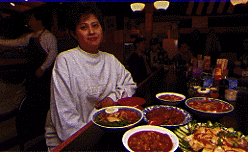[
homepage
|
subscribe
|
feedback
|
guestbook
|
contents
|
post
]
architecture
¥
art
¥
film
¥
music
¥
nitelife
¥
performing arts
¥
style
The timing is spot on: Madame Ang's menu at Kolaiya dovetails perfectly with
our post-bubble all-you-can-eat boom.

Far from the Tokyo mainstream, in obscure, wrong-side-of-the-tracks locations,
are the three restaurants that make up our award-winning pick of the year: the
Shin-Sekai chain. What these joints boast is a vital sense of immediacy--this
city has never before had Asian food of such intensity.
Shin-Sekai makes zero effort to tailor its menus and ambiance to local
sensibilities, nor to cash in on the yuppie boom in "ethnic" cuisines. Its
customer base is Shinjuku's substratum of expatriate Southeast Asians, who
demand the kind of meals they can order back home: honest, four-square cooking,
supercharged to the requisite spice levels, for rock-bottom prices and at hours
that suit their needs.
The driving force behind Shin-Sekai's uncompromising philosophy is Miyuki
Yamasaki, a.k.a. Madame Ang. Like most of her customers and kitchen staff, Ang
hails from the Malay Peninsula. With no background in the restaurant trade,
she arrived in Tokyo 10 years ago following her Japanese husband's transfer
home. The idea for Shin-Sekai remained in gestation until 1992, but since then
it has spawned three offshoots in as many years. Her aim, she says, is simple:
to provide the kind of food she knows and loves.
The original Shin-Sekai is a no-frills, short-order café converted from
an abandoned soba shop on the insalubrious edge of Kabukicho. Its
round-the-clock hours cater to a marginal crowd of students, off-the-record
piece workers, mizu shobai hostesses and businessmen. Son of Shin-Sekai
is a pared-down version of the original, serving eat-and-run, budget
teishoku meals out of a basement right below Okubo High Street. At both
premises, the joy of eating what is arguably the best Malaysian/Singapore food
in Japan is tempered by the sheer other-worldliness of the atmosphere, which
reverberates with Chinese dialects.
Madame Ang's newest venture taps a more accessible vein. Kolaiya is the first
restaurant in the city to introduce the steamboat, a hybrid stewpot-cum-grill
which now enjoys huge popularity throughout Malaysia (see TJ 12/95).
For Tokyo, the timing is spot on: Kolaiya's all-you-can-eat menu dovetails
perfectly with our post-bubble tabehodai boom. Marketed as an "ethnic"
version of that perennial local favorite, chanko nabe, steamboat has the
potential to draw a major mainstream--that is, non-Southeast
Asian--clientele.
With Shin-Sekai, Madame Ang has accomplished what many before her have not.
Her formula of full-throttle Asian food ups the ante for all of Tokyo's
Southeast Asian eateries, challenging them to deliver the same goods--although
few are likely to match her prices.
architecture
¥
art
¥
film
¥
music
¥
nitelife
¥
performing arts
¥
style
[
homepage
|
subscribe
|
feedback
|
guestbook
|
contents
|
post
]
Copyright © Tokyo Journal
